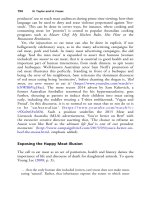The palgrave international handbook of a 212
Bạn đang xem bản rút gọn của tài liệu. Xem và tải ngay bản đầy đủ của tài liệu tại đây (38.21 KB, 1 trang )
Collecting Wildlife
207
Previous research (Nurse 2013a, 2011) identified a typology of wildlife
offenders concluding that five main types of offender existed as follows:
A. Traditional Criminals
B. Economic Criminals
C. Masculinities Criminals
D. Hobby Criminals
E. Stress Offenders
Utilising this typology (Nurse 2013a, 2011), animal collectors predominantly fall
within Model D (Hobby Offenders) and Model C (Masculinities Criminals).
Collecting where there is no direct benefit or financial gain to the offender (for
example, egg collecting) is primarily driven by the collecting behaviour as a
hobby or personal interest. Egg collectors, for example, primarily collect wild
birds eggs for personal use and gratification (see case study below). There is
no concrete evidence of any market for wild birds’ eggs; except where viable
eggs are being taken primarily for illegal bird breeding purposes. However
the theft of viable wild birds’ eggs is distinct from egg collecting per se,
where the end result is for a collector to obtain egg shells for their own
private collections, similar to other acquisitive activities such as stamp
collecting. Thus egg collectors and those engaged in large scale taxidermy
(as collectors), but who do not operate mainly as traders or dealers in dead
wildlife specimens, are involved in an activity largely situated within personal gratification discourse rather than the profit-driven activity which drives
much wildlife trafficking (Schneider 2008; Wyatt 2013).
Collecting in this context can be more readily likened to a hobby or
obsession, and the collection or acquisition of items is a primary motivator
rather than the activity being driven by business imperatives. In the case of
egg collecting, for example, offences are rarely committed by those directly
employed within the countryside (Nurse 2013a). Instead, the offences are
often committed by those employed (or unemployed) elsewhere and who
may travel specifically to commit their offences. This element of mens rea on
the part of the offender might account for the seriousness with which these
offences are considered by NGOs and the criminal justice agencies.
Collecting activities arguably attract disproportionate attention and response
by, for example, continuous enforcement activity aimed at collecting activity
that has limited impact in conservation terms and considerable adverse
publicity for an activity that is at the lower end of animal abuse criminality
(Nurse 2013a, 2013b).









